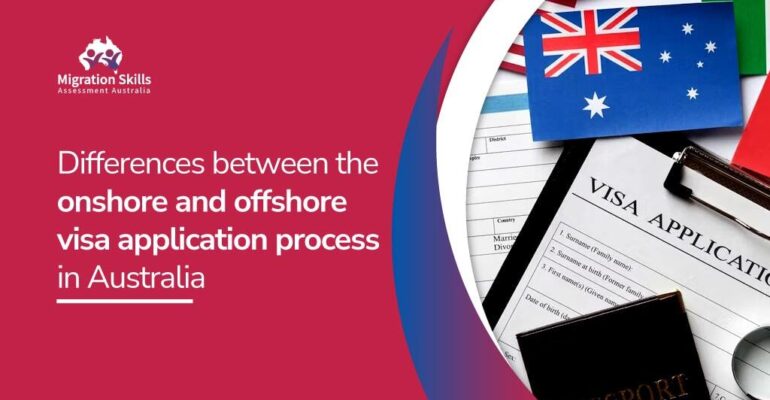Onshore and Offshore Visa Application Process in Australia

Onshore and Offshore Visa Application Process in Australia
Australia is a beautiful place that draws people seeking new opportunities. Whether you want to study, work, join a family, or become a permanent resident in Australia, you must know how to apply for a visa.
This guide will explain how to get an Australian visa. We’ll talk about two main ways: applying while you’re already in Australia (onshore) or applying from outside Australia (offshore). By the end of this guide, you’ll know the differences between these methods and can choose the right one for your immigration plans.
What are Onshore and Offshore visa applications?
If you’re thinking about applying for an Australian visa while you’re already in the country, it’s important to understand how the onshore visa application process works. To be eligible for an onshore application, you must be in Australia when you submit your application and when they approve it.
When you apply onshore, you will receive a bridging visa allowing you to stay in Australia while they process your main visa application. These bridging visas come in different types, each with its specific rules. Some bridging visas might limit your ability to leave Australia while your main visa is being processed, and others might restrict your work rights until your main visa is finalized.
It’s worth noting that onshore visa applications often take longer to process than offshore visa applications, and the application fees can be higher.
Note: The onshore partner visa application process follows a two-stage approach. In the first stage, you receive a temporary visa that allows you to live in Australia with your partner for two years. The second stage leads to a permanent visa, allowing you to live indefinitely with your partner in Australia.
If you are applying for an onshore partner visa and already have a visa when you apply, you will be granted a bridging visa that lets you stay in Australia until the onshore partner visa is approved.
Onshore Detention and Processing
Under the Migration Act, the detention of non-citizens in Australia without valid visas is obligatory, irrespective of their circumstances. Once detained, unlawful non-citizens must remain detained until they receive a visa or get removed from Australia.
International concerns about Australia’s mandatory detention system align with domestic entities’ concerns. The United Nations Human Rights Committee has determined that Australia violates its international commitments under the ICCPR article due to its mandatory detention practices.
Learn More: Skillselect Visa Categories: Which Visa Pathway is Right for You? ✈️✈️
Offshore Visa Application
To apply for offshore or permanent resident visas for Australia, you must be outside of Australia. You must be outside Australia when you submit your visa application and when the Australian immigration authorities approve it.
When the Australian immigration authorities are ready to process your application, they will notify you. At that point, you can leave Australia while they process your visa. You can explore destinations like New Zealand or anywhere outside Australia that interests you; you do no need to return to your home country. Leaving Australia is a requirement for the visa to move forward.
If you’re considering moving to Australia or have questions about which visa suits your situation, our team of professionals can provide expert guidance and advice.
Note: It’s crucial to differentiate between the offshore partner visa and the onshore partner visa. The offshore partner visa requires you to apply while living in another country. Once they approve it, you can enter Australia. This visa has two stages.
The first stage provides a temporary visa for living in Australia with your partner, and the second stage involves obtaining a permanent visa. To apply for an offshore partner visa, you must be outside Australia when you apply and remain outside the country until they make a decision.
Read More: How to write a complete RPL Report for ACS Skills Assessment? ✈️✈️
Key differences between Onshore and Offshore visa applications
Below are the key differences between onshore and offshore visa applications:
1. Location of the Applicant
The most evident difference between onshore and offshore visa applications is the applicant’s location at the time of submission. Onshore applicants are present within Australia when they apply, while offshore applicants are outside Australia’s borders.
2. Bridging Visas
Onshore applicants get granted bridging visas that are affected once their visa expires. These bridging visas allow applicants to maintain lawful status in Australia while awaiting the outcome of their new visa application. In contrast, offshore applicants do not need bridging visas since they are not in Australia during the application process.
3. Processing Times
Processing times can vary for both onshore and offshore visa applications. In some cases, onshore applications may get processed more due to the applicant’s proximity to the Department of Home Affairs. Yet, the processing time can differ depending on the visa category and individual circumstances.
4. Access to Services
Onshore applicants have access to various services and benefits that may not be available to offshore applicants. They can access healthcare services through Medicare, work, and enroll in educational programs. Offshore applicants must rely on services in their home country or location.
5. Eligibility for Certain Visa Categories
Specific visa categories may only be available to onshore or offshore applicants. For example, partner and student visas get applied for onshore, while some family reunion visas are for offshore applicants.
6. Travel Restrictions
Onshore applicants can continue to travel within Australia while their visa application is being processed. In contrast, offshore applicants must remain outside Australia until a decision is made on their visa.
Common Onshore Visa Categories
While various visas get applied for onshore, some of the most common categories include:
1. Onshore Student Visa
The onshore student visa is a popular choice for international students looking to continue their studies in Australia. It allows students to remain in the country while pursuing their education, and the application process can be straightforward if all requirements are met.
2. Partner Visas (Onshore)
Partner visas are designed for individuals in genuine relationships with Australian citizens, permanent residents, or eligible New Zealand citizens. Applying for a partner visa onshore allows couples to remain together while processing the application.
3. Skilled Migration (Onshore)
Onshore applications are an option for skilled workers holding temporary skilled visas who meet the criteria for permanent skilled migration. This pathway can lead to permanent residency in Australia, offering a promising future.
4. Protection Visas (Onshore)
Protection visas are intended for individuals seeking asylum or refugee status in Australia. Applying onshore is often the most feasible option for those already within the country’s borders.
Read more: Engineering Jobs in Australia: A comprehensive list for Skills Assessment. 📑📑
Common Offshore Visa Categories
While there are many visa options available for offshore applicants, some common categories include:
1. Visitor Visas (Offshore)
Visitor visas are suitable for individuals planning to visit Australia for tourism, visiting family, or conducting business. These visas get applied for from the applicant’s home country.
2. Family Visas (Offshore)
Family reunion visas, including parent, child, or partner visas, are often applied for by individuals outside Australia with family members willing to sponsor them.
3. Work Visas (Offshore)
Skilled workers seeking employment in Australia can apply for various work visas, such as the Subclass 482 Temporary Skill Shortage visa or the Subclass 189 Skilled Independent visa, from offshore locations.
4. Humanitarian Visas (Offshore)
If you are outside Australia and need humanitarian help or are seeking protection, you may apply for humanitarian visas from an offshore location.
Factors to consider on Visa Applications in Australia
Now that we have established a broad understanding of onshore and offshore visa applications, it’s time to consider the factors that should influence your decision when choosing these two approaches.
1. Your Current Location
Your location is pivotal in determining whether you can apply for an onshore or offshore visa application. If you are already in Australia, an onshore application is an option. If you are outside Australia, you will generally need to apply offshore.
2. Visa Type
The type of visa you are applying for may dictate whether you can apply for an onshore or offshore visa application. Some visas, like partner visas, are designed for onshore applicants, while others, like visitor visas, get applied for offshore.
3. Processing Times
Consider the processing times for the visa category you are interested in. Onshore applications may sometimes get processed faster due to proximity to immigration authorities. But, this can differ depending on the visa subclass and individual circumstances.
4. Access to Services
Think about whether you need access to Australian services, such as healthcare or education, during the application process. Onshore applicants have an advantage in this regard.
5. Travel Plans
Consider your travel plans. If you must leave Australia for any reason while your visa application is pending, an offshore visa application might be more suitable. It’s essential to plan your application timing to avoid any inconveniences.
6. Eligibility Criteria
Review the eligibility criteria for your selected visa. Some visas’ specific requirements may affect your onshore or offshore application eligibility. Ensure you meet all requirements before proceeding.
Read more: Engineers Australia Assessment Validity. 📑📑
In-Depth Analysis of Onshore and Offshore Visa Categories
This section will analyze some of the most sought-after visa categories for both onshore and offshore applicants. It will give you a more comprehensive understanding of each category’s requirements and advantages.
Onshore Student Visa
Overview
The onshore student visa allows international students already in Australia to continue their studies. This visa category is popular among those seeking a world-class education and the opportunity to explore the country while studying.
Advantages
a. No Need to Leave Australia: Onshore student visa applicants can continue to live in Australia while their application is being processed. It eliminates the need to return to their home country, saving time and potential travel expenses.
b. Bridging Visas: Onshore student visa applicants are often granted bridging visas after their current student visa expires. These bridging visas allow students to maintain lawful status while waiting for a decision.
c. Access to Services: Being onshore grants students access to various services and benefits, including healthcare through Medicare and the ability to work to support their studies.
d. Closer Contact with Authorities: If additional documentation or information is required, onshore applicants can provide it, given their proximity to the Department of Home Affairs. These documents can enhance the processing of their visa application.
Eligibility
To be eligible for an onshore student visa, applicants must meet specific criteria, including:
- Holding a proper student visa at the time of application.
- Enrolled in a registered course of study.
- Meeting health and character requirements.
- Demonstrating financial capacity to cover living expenses and tuition fees.
Read More: Immigration to Australia as an Engineering Manager for PR Visa. ✈️✈️
Offshore Student Visa
Overview
Offshore student visas are designed for international students who intend to study in Australia but are currently outside the country. This category allows individuals to embark on their educational journey in Australia.
Advantages
a. Wider Range of Visa Options: Some student visas, particularly those for English language courses, vocational education, or higher education, get applied offshore.
b. Consistency in Processing: Australian embassies, high commissions, or consulates process Offshore student visa applications in the applicant’s home country or nearest location. This consistency can make tracking the application’s progress and receiving updates easier.
Eligibility
The eligibility criteria for offshore student visas include:
- Acceptance into a registered course of study.
- Meeting health and character requirements.
- Demonstrating enough financial capacity to cover tuition fees and living expenses in Australia.
Conclusion
Australia offers exciting opportunities for those seeking a fresh start. Applying for a visa can be complex, whether you’re inside Australia or in another country. To make the best decision, it’s essential to understand the differences between these two options and consider your unique situation.
Choosing between onshore and offshore visa applications should align with your goals and circumstances. Whether you aim to study, reunite with family, work, or become a permanent resident, Australia provides various visa options.
To simplify this process, seeking guidance from experts like registered migration agents, immigration lawyers, or the Department of Home Affairs is advisable. They can assist you in preparing your application. With the right information and support, you can navigate the Australian visa process and look forward to a brighter future in Australia.

 WhatsApp Quick Contact
WhatsApp Quick Contact

 WhatsApp Quick Contact
WhatsApp Quick Contact
